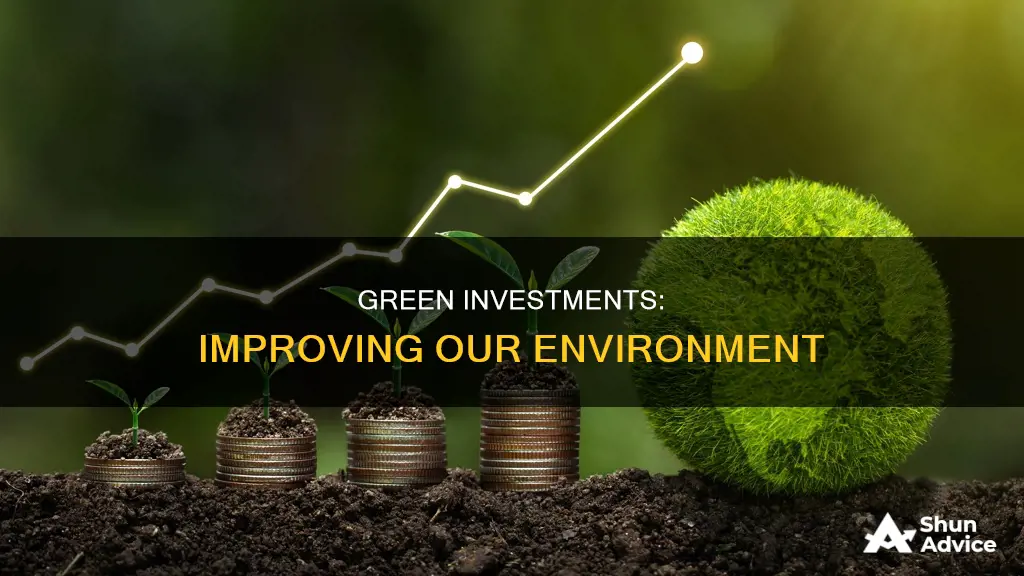
People invest in a variety of ways to promote environmental improvement and sustainability. This includes investing in renewable energy technologies such as wind, solar, and hydropower, as well as green transportation, pollution controls, waste reduction, and sustainable agriculture. Individuals can also invest in water infrastructure, eco-friendly brands, and crowdfunding campaigns for green businesses. Additionally, investing in securities that support green initiatives, green bonds, and banking alternatives that give back to the environment are also popular choices. Some people choose to donate directly to environmental groups or invest in companies with strong environmental, social, and governance (ESG) ratings.
| Characteristics | Values |
|---|---|
| Securities that support green initiatives | Green mutual funds, green ETFs, green stocks |
| Green bonds | iShares Global Green Bond (BRGN), VanEck Vectors Green Bond (GRNB), Domini Social Bond Fund (DFBSX), CSIF Bond Portfolio A (CSIBX), TIAA-CREF Core Impact Bond Fund (TSBIX) |
| Banking alternatives that give back to the environment | B-corp, Global Alliance for Banking on Values (GABV), 1% For The Planet |
| Eco-friendly brands | Beyond Meat, Who Gives A Crap |
| Crowdfunding campaigns for green businesses | Indiegogo, Startsomegood |
| Environmental groups | Environmental Defense Fund, The Nature Conservancy |
| Renewable energy | Wind, solar, hydropower |
| Clean transportation | Electric vehicles, zero-emissions shipping, green hydrogen |
| Food and agriculture innovation | No-till farming, solar-powered irrigation, hydroponic growing, meat alternatives |
| Nature-based solutions | Peatlands, mangroves, sea grasses, salt marshes |
| Indigenous communities | |
| Girls and women | |
| Peace and diplomacy |
What You'll Learn

Invest in renewable energy and energy efficiency
Investing in renewable energy and energy efficiency is one of the most effective ways to improve the environment. Here are some reasons why:
Reducing Greenhouse Gas Emissions
Fossil fuels, such as coal, oil, and gas, are the largest contributors to global climate change, accounting for over 75% of greenhouse gas emissions. By investing in renewable energy sources like solar, wind, and hydropower, we can significantly reduce these emissions and curb the impacts of climate change.
Improving Air Quality
Burning fossil fuels releases harmful pollutants into the air, causing air pollution that is damaging to both people's health and the environment. Renewable energy sources, on the other hand, emit little to no greenhouse gases or pollutants, leading to improved air quality and reduced health risks.
Increasing Energy Accessibility and Security
Renewable energy sources are available in abundance worldwide and are often more accessible than fossil fuels. By investing in renewable energy and energy efficiency, we can improve energy security and ensure a more stable and equitable distribution of energy resources.
Driving Economic Growth and Job Creation
The renewable energy sector offers significant economic opportunities. Investing in this sector can drive innovation, create jobs, and foster inclusive economic growth. According to the International Energy Agency (IEA), the transition to clean energy could create an estimated 14 million new jobs in the energy sector.
Long-Term Cost Savings
While the upfront costs of investing in renewable energy can be high, the long-term benefits outweigh the initial expenses. Improving energy efficiency reduces energy consumption and lowers operating costs. Additionally, the costs of renewable energy technologies are dropping rapidly, making them an increasingly attractive investment option.
Diversifying Energy Sources
Investing in renewable energy and energy efficiency helps to diversify energy sources and reduce reliance on a single fuel type. This diversification enhances resilience and reduces vulnerability to fluctuations in fuel prices, ensuring a more stable and secure energy future.
Policy Support and Incentives
Many governments and organizations are committed to promoting renewable energy and energy efficiency. Policies, incentives, and subsidies are in place to encourage investments in this sector. For example, the Biden Administration in the United States has made significant investments in clean energy technologies and infrastructure.
Public Health Benefits
In addition to the environmental benefits, investing in renewable energy and energy efficiency has significant public health advantages. By reducing air pollution and greenhouse gas emissions, we can lower the incidence of respiratory and cardiovascular diseases, improve overall public health, and reduce healthcare costs.
Long-Term Sustainability
Renewable energy sources are naturally replenished and provide a sustainable alternative to finite fossil fuel resources. By investing in renewable energy, we can ensure a more secure and resilient energy future for generations to come.
Community Empowerment
Investing in renewable energy and energy efficiency at a local level can empower communities, particularly in developing regions. It can provide access to affordable and reliable energy, drive economic development, and improve the overall quality of life for people in these regions.
Young People: Invest Now, Gain Later
You may want to see also

Invest in clean transportation
Investing in clean transportation is an essential aspect of promoting environmental improvement. This sector is almost entirely dependent on fossil fuels, contributing significantly to the world's greenhouse gas emissions. Here are some ways to invest in clean transportation:
Electric Vehicles and Zero-Emissions Shipping
Electric vehicles (EVs) and zero-emissions shipping are at the forefront of clean transportation. The transition to electric and zero-emission vehicles is crucial for reducing pollution and improving air quality. This shift can be supported by investing in the necessary infrastructure, such as EV charging stations, and incentivizing the purchase and installation of these systems.
Green Hydrogen as an Alternative Fuel
Green hydrogen, produced by electrolyzing water using renewable energy, is a promising alternative fuel for clean transportation. Investing in the development and distribution of green hydrogen can help reduce emissions and improve accessibility to clean energy sources for transportation.
Public Transportation and Intercity Rail
Investing in public transportation and intercity rail can have a significant impact on reducing emissions and improving accessibility. This includes allocating funds for transit systems, such as bus rapid transit, commuter rail, and intercity rail like Amtrak. These investments can help expand the reach of public transportation, providing more sustainable travel options for people to access education, healthcare, and economic opportunities.
Bicycle and Pedestrian Infrastructure
Allocating funds towards developing and improving bicycle and pedestrian infrastructure is another way to promote clean transportation. This includes creating dedicated bike lanes, pedestrian pathways, and safe crossings, encouraging people to opt for walking or cycling for shorter distances instead of driving, thereby reducing vehicle emissions.
Traffic Management and Road Safety Improvements
Investments in intelligent traffic management systems and road safety improvements can also contribute to clean transportation goals. Efficient traffic management can reduce congestion and idling times, minimizing vehicle emissions. Additionally, road safety improvements, such as installing speed bumps or implementing traffic calming measures, can help prevent accidents and reduce the environmental impact of emergency response and repair work.
By investing in these areas, we can accelerate the development and adoption of clean, efficient, and low-carbon transportation technologies, contributing to a more sustainable future.
Investing: Nice People Turn Nasty
You may want to see also

Invest in nature-based solutions
Investing in nature-based solutions is one of the seven ways to preserve our planet for future generations. Nature itself offers one of the most cost-effective ways to tackle climate change. Protecting, sustainably managing, and restoring natural ecosystems can help mitigate the effects of global warming and foster biodiversity.
Peatlands, for example, cover just 3% of the Earth's surface but store almost one-third of the world's carbon. Similarly, the ocean, which produces half of the planet's oxygen and provides food for billions, offers nature-based solutions. Planting and protecting mangroves, seagrasses, and salt marshes can absorb up to 10 times as much carbon as forests on land.
Investing in renewable energy technologies, such as wind, solar, and hydropower, is another way to promote improving the environment. Green transportation, such as electric vehicles, and sustainable agriculture are also avenues to explore.
When it comes to sustainable investing, investors aim to achieve financial returns while promoting long-term environmental or social value. Combining traditional investment approaches with environmental, social, and corporate governance (ESG) insights can lead to more comprehensive analyses and better investment decisions.
There are several strategies for sustainable investing, including negative/exclusionary screening, positive/best-in-class screening, and activist investing. Impact investing, which includes community investing and financing businesses with clear social or environmental purposes, is another strategy.
Salomon Ski Investors: Who's Behind the Brand?
You may want to see also

Invest in green businesses
Investing in green businesses is one of the most effective ways to promote environmental improvement. Here are some reasons why investing in green businesses is a great idea, as well as some specific examples of how to do so:
Investing in green businesses is a way to promote environmental improvement while also seeking financial gains. Sustainable investing encourages companies to adopt sustainable practices, which can lead to long-term social and financial benefits. By investing with a focus on environmental and social value, individuals and businesses can contribute to positive social change while potentially achieving strong financial returns. This concept is known as the triple bottom line, which suggests that organisations should focus not only on financial performance but also on their social and environmental impacts.
How to Invest in Green Businesses:
There are several ways to invest in green businesses and promote environmental improvement:
- Securities and Mutual Funds: Invest in securities and mutual funds that support green initiatives and environmentally responsible companies. Examples include green mutual funds, green ETFs, and green stocks.
- Green Bonds: Invest in green bonds, which are similar to regular bonds but directed towards environmental projects such as fighting climate change, preventing pollution, and protecting ecosystems.
- Alternative Banking: Choose banking alternatives that give back to the environment, such as fossil fuel-free banks and credit unions with environmental certifications.
- Eco-Friendly Brands: Support eco-friendly brands and businesses, such as those offering renewable energy solutions or electric vehicles.
- Crowdfunding Campaigns: Participate in crowdfunding campaigns dedicated to green businesses and environmental causes. Platforms like Indiegogo and Startsomegood offer opportunities to fund specific campaigns that align with your values.
- Environmental Organisations: Donate to environmental organisations and groups that are actively making a difference, such as the Environmental Defense Fund and The Nature Conservancy.
- Water Infrastructure: Invest in companies focused on water infrastructure, as water is a diminishing resource and a critical component of renewable energy. Examples include American Water and Essential Utilities.
- Pollution Control and Waste Reduction: Support companies in the pollution control industry, which works to reduce greenhouse gas emissions and minimise harmful chemicals released into the environment.
- Sustainable Agriculture: Invest in organic farms and sustainable fishing practices to reduce the ecological footprint of agriculture and promote environmentally friendly food production.
By investing in green businesses, you can contribute to environmental improvement while also seeking financial opportunities. These examples provide a starting point for individuals looking to make a positive impact through their investments.
Retirement Investments: Living Off Profits
You may want to see also

Invest in environmental groups
Investing in environmental groups is one of the most effective ways to promote positive environmental change. Here are some reasons why investing in environmental groups is a crucial aspect of improving the environment:
Impact of Environmental Groups
Environmental groups are dedicated to tackling pressing environmental issues and driving change. They often have strong track records and evidence-based strategies for combating climate change, protecting ecosystems, and advocating for sustainable practices. These groups leverage their expertise and resources to influence policies, raise awareness, and implement solutions on a local, national, or global scale. Their efforts can range from protecting natural habitats and conserving endangered species to promoting renewable energy sources and educating communities about environmental stewardship.
Types of Environmental Groups
There are various types of environmental groups, each with its own focus and approach. These include non-profit organizations, such as the Environmental Defense Fund and The Nature Conservancy, which have a long history of successful conservation initiatives. Additionally, groups like As You Sow, a nonprofit shareholder advocacy group, work to hold companies accountable and promote environmentally conscious business practices. Environmental groups can also take the form of grassroots movements, indigenous communities, or local organizations dedicated to preserving their surrounding natural environments.
Benefits of Investing in Environmental Groups
Investing in environmental groups offers several advantages. Firstly, it allows individuals to support evidence-based initiatives with proven track records, ensuring their donations have a tangible impact. Secondly, it empowers these organizations to expand their operations, hire more experts, and implement large-scale projects. This, in turn, strengthens their ability to influence policies, collaborate with governments and businesses, and drive systemic change. Finally, investing in environmental groups fosters the development of innovative solutions, such as new technologies, sustainable practices, and conservation strategies, which can have far-reaching benefits for the planet and future generations.
Ways to Invest in Environmental Groups
There are multiple ways to invest in environmental groups and promote their mission. Individuals can choose to donate directly to reputable environmental organizations, supporting their research, advocacy, and conservation efforts. Additionally, investing in green securities, such as green mutual funds or green bonds, provides funding for environmentally focused companies and initiatives. Joining banking alternatives that prioritize environmental sustainability is another way to support environmental groups indirectly. These alternatives may include fossil fuel-free banks, credit unions with environmental certifications, or financial institutions that pledge to donate a percentage of their profits to environmental causes.
Long-Term Impact
Investing in environmental groups not only addresses immediate environmental concerns but also contributes to long-term sustainability. By supporting organizations dedicated to preserving the planet, individuals can help create a greener and more resilient future. This includes mitigating the impacts of climate change, protecting biodiversity, and ensuring that future generations can thrive in a healthy and sustainable environment.
In conclusion, investing in environmental groups is a powerful way to promote positive environmental change. By supporting these organizations, individuals can drive innovation, influence policies, and create a more sustainable future for generations to come.
Homes: The Ultimate Investment?
You may want to see also
Frequently asked questions
Green investments include businesses or funds that seek to reduce harmful pollutants or use resources more sustainably. Examples include renewable energy technologies such as wind, solar, and hydropower, as well as electric vehicles and sustainable agriculture.
You can research a company's annual sustainability reports, looking for concrete goals, statistics, and deadlines. You can also check if their corporate governance structure includes members who prioritise the environment.
ESG stands for Environmental, Social, and Governance factors. ESG funds are investment funds that include companies that score highly in these areas. Examples of ESG funds include Vanguard, State Street, Fidelity, and BlackRock.
You can research and invest in individual companies that align with your values. You can also invest in mutual funds or exchange-traded funds (ETFs) that focus on environmental or sustainable initiatives. Additionally, you can work with a financial advisor who specialises in sustainable investing.
Sustainable investing allows you to align your investments with your values and promote positive social and environmental change. It can also be financially beneficial, as companies with strong ESG ratings tend to have lower exposure to risk and can lead to greater profits and higher dividends.







